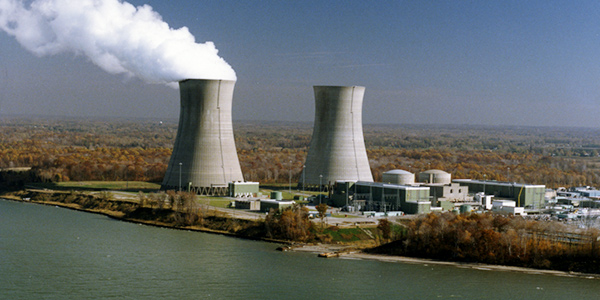By Christen Smith
The Ohio Senate on Wednesday cleared a controversial plan to curb state renewable energy mandates and create subsidies for nuclear and coal plants, but the House of Representatives’ stamp of approval is still likely two weeks away.
Nineteen senators — 17 Republicans and two Democrats — approved House Bill 6 after months of hearings that debated the merits of saving FirstEnergy Solutions’ nuclear reactors at the Davis-Besse and Perry facilities near Lake Erie. The bankrupt company said it will begin shutting down the plants over the next few years without ratepayer subsidies to offset the flood of cheap natural gas that makes it difficult to compete in the wholesale energy market. (See FirstEnergy Extends the Clock on Ohio Nuke Plan.)
Two Ohio Valley Electric Corp. coal plants would also receive funding, which some critics have described as a sweetener to attract support from the state’s other electric distribution utilities (EDUs). (See Ohio Nuke Bill: A Worthwhile Trade-off?)
The latest iteration that moved out of the Senate Energy and Public Utilities Committee earlier this week would collect $150 million for the plants starting in 2021 via ratepayer fees that range from 85 cents for residential customers up to $2,400 for large industrial plants. The charge would sunset in 2027 and the Public Utilities Commission would audit the nuclear facilities each year between 2022 and 2026 to determine if the subsidies are still needed — an attempt to placate critics who insist the plants aren’t losing money at all.
Another $20 million would support six solar power projects being built throughout the state. The OVEC fees would range from $1.50 for residential customers to $1,500 for commercial and industrial customers, and would be subject to OVEC revocation.
The bill also preserves a scaled-back renewable portfolio standard, dropping from 12.5% by 2027 to 8.5% until 2025, with no continuation of the mandate thereafter.
The House didn’t vote on the plan but returns to session Aug. 1. Speaker Larry Householder (R) has reportedly worked behind the scenes to secure bipartisan support in his chamber by pushing the fees for OVEC and slashing RPS mandates long unpopular among state Republicans.
“This will give Ohio an energy plan that puts Ohioans first,” he said when the plan cleared the House Energy and Natural Resources Committee in May. “We’re keeping good-paying jobs here in Ohio and maintaining a diverse energy portfolio.”
Although the current version of HB 6 — Ohio’s Clean Air Act — walks back some of the House-approved components, critics insist the bill remains deeply flawed and misguided. The Sierra Club said it would wreck the state’s potential to become a leader in wind and solar development all for the sake of a “regressive” and burdensome surcharge that would disproportionately hurt small businesses.
The Ohio Consumers Council and the Ohio Manufacturers’ Association sent a joint resolution to Gov. Mike DeWine on Wednesday urging him to veto the bill, saying it will thwart the benefits customers receive from competitive energy markets. A spokesperson for the governor did not return request for comment, but DeWine has signaled support for the bill in the past few months.
FirstEnergy did not respond to requests for comment from RTO Insider on Thursday. The company extended the June 30 deadline for legislative action, remaining “optimistic” that lawmakers would approve the bill in the coming weeks.



